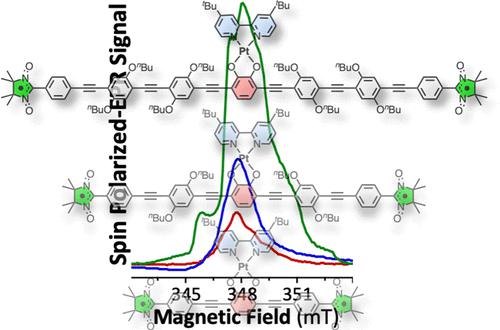当前位置:
X-MOL 学术
›
J. Am. Chem. Soc.
›
论文详情
Our official English website, www.x-mol.net, welcomes your feedback! (Note: you will need to create a separate account there.)
Photoinduced Magnetic Exchange-Jump Promotes Ground State Biradical Electron Spin Polarization
Journal of the American Chemical Society ( IF 15.0 ) Pub Date : 2024-03-22 , DOI: 10.1021/jacs.4c00930 Martin L. Kirk 1, 2, 3, 4 , David A. Shultz 5 , Anil Reddy Marri 5 , Art van der Est 6
Journal of the American Chemical Society ( IF 15.0 ) Pub Date : 2024-03-22 , DOI: 10.1021/jacs.4c00930 Martin L. Kirk 1, 2, 3, 4 , David A. Shultz 5 , Anil Reddy Marri 5 , Art van der Est 6
Affiliation

|
Photoinduced electron spin polarization (ESP) is reported in the electronic ground states of three Pt(II) complexes comprised of two S = 1/2 nitronyl nitroxide (NN) radicals attached through different length para-phenylethynyl bridges to the 3,6 positions of a catecholate (CAT, donor) and 4,4′-di-tert-butyl-2,2′-bipyridine (bpy, acceptor). Complexes 1–3 have from 17 to 41 bonds separating NN radicals and display cw-EPR spectra consistent with |JNN-NN| ≫ |aN|, |JNN-NN| ≥ |aN|, and |JNN-NN| < |aN|, respectively, where JNN-NN is the magnetic exchange coupling between NN radicals in the electronic ground state, and aN is the isotropic 14N hyperfine coupling constant. Light-induced transient EPR spectra characterized as enhanced ground-state absorption were observed for all three complexes using 532 nm pulsed laser excitation into the ligand-to-ligand charge transfer (LL’CT) band of the (CAT)Pt(bpy) chromophore. The magnitude of the observed ESP increases in the order 1 < 2 < 3 and is inversely correlated with the magnitude of ground-state JNN-NN. In addition to the experimental observation of net absorptive polarization in 1–3, light excitation also produces multiplet polarization in 2. Since the weak dipolar coupling leads to a strong spectral overlap of the absorptive and emissive components, the multiplet polarization is not observed in 1 and 3 and is very weak in 2. The ability to spin-polarize multiple radical spins with a single photon is anticipated to advance new photoinduced multi qubit/qudit ESP protocols for quantum information science applications.
中文翻译:

光致磁交换跃迁促进基态双自由基电子自旋极化
据报道,三个 Pt(II) 配合物的电子基态存在光致电子自旋极化 (ESP),该配合物由两个 S = 1/2 硝基氮氧自由基 (NN) 自由基组成,通过不同长度的对苯乙炔基桥连接到 3,6 位。儿茶酚酸酯(CAT,供体)和 4,4'-二叔丁基-2,2'-联吡啶(bpy,受体)。配合物1 – 3具有 17 至 41 个分隔 NN 自由基的键,并显示与 | 一致的 CW-EPR 光谱。J NN-NN | ≫ |一个N |, | J NN-NN | ≥ |一个N | 和 | J NN-NN | <| a N | ,其中J NN-NN是电子基态下 NN 基团之间的磁交换耦合,a N是各向同性14 N 超精细耦合常数。使用 532 nm 脉冲激光激发 (CAT)Pt(bpy) 发色团的配体到配体电荷转移 (LL'CT) 带,观察到所有三种复合物的光诱导瞬态 EPR 光谱,其特征是增强的基态吸收。观测到的 ESP 的大小按1 < 2 < 3的顺序增加,并且与基态J NN-NN的大小成反比。除了1 – 3中实验观察到的净吸收偏振之外,光激发还会产生2中的多重偏振。由于弱偶极耦合导致吸收和发射分量的强烈光谱重叠,因此在1和3中未观察到多重偏振,并且在2中非常弱。利用单个光子自旋极化多个自由基自旋的能力预计将推动用于量子信息科学应用的新型光诱导多量子位/量子 ESP 协议。
更新日期:2024-03-22
中文翻译:

光致磁交换跃迁促进基态双自由基电子自旋极化
据报道,三个 Pt(II) 配合物的电子基态存在光致电子自旋极化 (ESP),该配合物由两个 S = 1/2 硝基氮氧自由基 (NN) 自由基组成,通过不同长度的对苯乙炔基桥连接到 3,6 位。儿茶酚酸酯(CAT,供体)和 4,4'-二叔丁基-2,2'-联吡啶(bpy,受体)。配合物1 – 3具有 17 至 41 个分隔 NN 自由基的键,并显示与 | 一致的 CW-EPR 光谱。J NN-NN | ≫ |一个N |, | J NN-NN | ≥ |一个N | 和 | J NN-NN | <| a N | ,其中J NN-NN是电子基态下 NN 基团之间的磁交换耦合,a N是各向同性14 N 超精细耦合常数。使用 532 nm 脉冲激光激发 (CAT)Pt(bpy) 发色团的配体到配体电荷转移 (LL'CT) 带,观察到所有三种复合物的光诱导瞬态 EPR 光谱,其特征是增强的基态吸收。观测到的 ESP 的大小按1 < 2 < 3的顺序增加,并且与基态J NN-NN的大小成反比。除了1 – 3中实验观察到的净吸收偏振之外,光激发还会产生2中的多重偏振。由于弱偶极耦合导致吸收和发射分量的强烈光谱重叠,因此在1和3中未观察到多重偏振,并且在2中非常弱。利用单个光子自旋极化多个自由基自旋的能力预计将推动用于量子信息科学应用的新型光诱导多量子位/量子 ESP 协议。



























 京公网安备 11010802027423号
京公网安备 11010802027423号